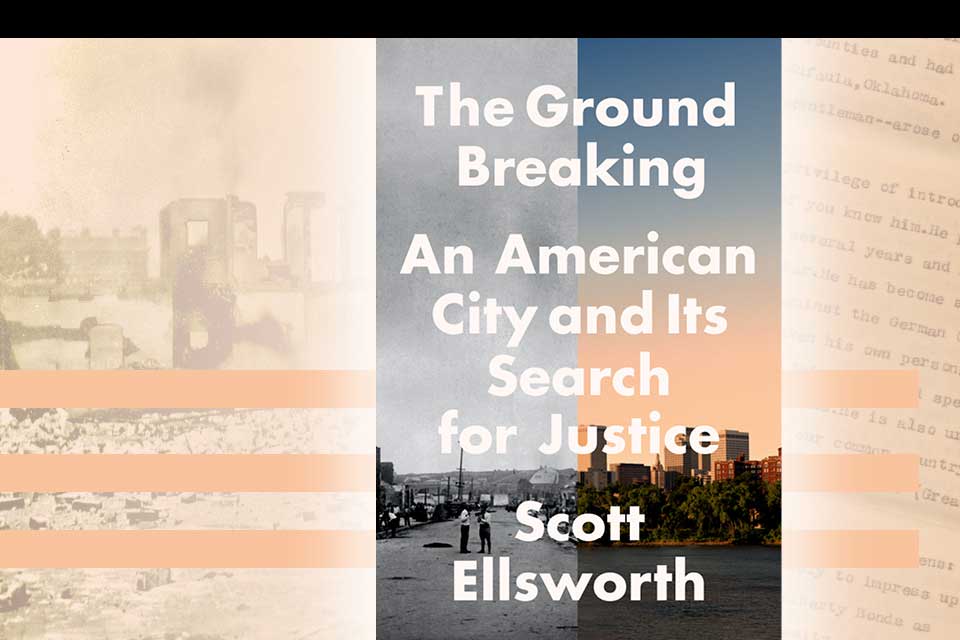Writing the History of the Tulsa Race Massacre Narrative

Scott Ellsworth’s latest book, The Ground Breaking: An American City and Its Search for Justice (Dutton, 2021) finds the historian returning to the subject of the Tulsa Race Massacre some forty years after his landmark book Death in a Promised Land. Though scholarship on the events of May 31 and June 1 of 1921 has amassed exponentially in the intervening four decades, The Ground Breaking resists the urge to monetize the centennial anniversary of unspeakable evil by offering a more detailed account of black trauma at the hands of a lawless mob of white Tulsans drunk on the myth of racial supremacy. Ellsworth’s role in the necessary work of building that historical narrative, begun in Death in a Promised Land and culminating in 2001 with his contribution to the final report by the Oklahoma Commission to Study the Tulsa Race Riot of 1921, has now become part of the story of our understanding of the race massacre as it continues to deepen. The Ground Breaking is the story of a writer’s entanglement with one of the darkest episodes in American history.
Ellsworth’s recounting of the Greenwood massacre that opens the book is heartrending and mercifully brief. More impressionistic than expository, the narrative grounds the senseless violence as being enacted upon people with names and knowable histories. This approach also obliquely outlines one of the gaping holes in the Tulsa narrative that, thus far, remains otherwise invisible – the identities of the white Tulsans who committed these crimes. While unrepentant murderers and thieves do occasionally bubble up in the book, usually as hearsay in the form of family stories, the actual holding of accountability is reserved for nonhuman entities. As Ellsworth documents the slow winnowing of living survivors, I couldn’t help but wonder how many perpetrators were still living and dying as the slow gears of scholarship and justice ground away in order to produce the historical narrative we have today; a narrative in which the principal actors are still conveniently anonymous.
I couldn’t help but wonder how many perpetrators were still living and dying as the slow gears of scholarship and justice ground away in order to produce the historical narrative we have today.
As the book moves past the massacre and into the decades of resurgence and decay that gripped Greenwood in its wake, the story is nurtured by individuals from within and without the community. While not widely known, eyewitness accounts were, in some cases, entered into the public record and, in others, circulated in whispers among the black and white communities alike in Tulsa. One of Ellsworth’s most valuable accomplishments in this book is to document the progressively rich pool of scholarship surrounding the massacre, serving as a kind of literature review nestled within the character sketches and vignettes that connect one generation to the next.
Ellsworth closes the first section with the story of his own engagement with the Tulsa story, culminating in the publication of Death in the Promised Land. He shares an anecdote of meeting the famed historian John Hope Franklin while working on the book. After having breached protocol in correcting one of the most celebrated African American historians of the twentieth century on a particular fact regarding the massacre, Ellsworth received a generous blurb from Franklin to adorn his new book. While I was moved by Franklin’s generosity, the moment gave me pause to wonder why Franklin, whose father represented the black citizens of Tulsa who were put on trial after the massacre, never published on Tulsa himself? In looking back over Ellsworth’s trail in piecing together the massacre narrative, it became plain to me that he was simply able to operate in spaces in which Franklin himself would never have been allowed, whether by virtue of his reputation or that of his race.
To his credit, Ellsworth seems all too aware of the white privilege that allowed him to research, write, and publish a history that fundamentally belonged to a community other than his own. He foregrounds his eyewitnesses and their life stories, reanimating them to speak their truths with interesting details about their complex lives, which spooled outward from the trauma that had been buried. The result is a book that feels very much of this time, when the names of those martyred by police violence are invoked as a cultural act of magic against the silence that has, for too long, prevailed.
The Ground Breaking feels very much of this time, when the names of those martyred by police violence are invoked as a cultural act of magic against the silence that has, for too long, prevailed.
The book’s second section focuses primarily on the Oklahoma Commission to Study the Tulsa Race Riot, of which Ellsworth was a contributing member. For those who followed the commission’s course, from its formation 1996 to the release of the final report in 2001, Ellsworth provides a lot of fascinating behind-the-scenes information about the political and social currents that impacted its work. Though the commission’s call for direct reparations to remaining survivors went unheeded upon publication of the final report, the accompanying document entered into the public record the most comprehensive examination of any event in Oklahoma history and forever dispelled the silence around the burning of Greenwood and the murder of its occupants.
The book’s final act is dedicated to the search for mass graves, the existence of which haunted the backdrop of nearly every eyewitness account. It is in this section that The Ground Breaking takes on the tone of a true-crime novel. With the murderers forever anonymized and the weapon and motive all accounted for, all Ellsworth’s narrative lacks for a conclusion is a body. After years of languishing in political “to-do” piles, the hunt for the mass graves is restarted by Tulsa mayor G. T. Bynum, motivated in no small part by Tulsa being swept up in a national narrative of police violence against black and brown bodies through the murder of Terence Crutcher by Tulsa police officer Betty Jo Shelby. As the book marches through its third section, the narrative tension of whether or not these many years of inquiry can finally uncover bodies hitherto lost to the eddies of time pulls the reader to the very end.
As Ellsworth ably documents, the Tulsa Race Massacre has taken its rightful place in the fabric of American social history as one of the vilest acts of racially motivated terrorism ever enacted on American soil. Now the subject of novels, plays, conferences, dances, and even superhero narratives, the memory of Greenwood and all that was lost in those two days of fire is likely to echo in the broader narrative of the struggle to force America’s future to bend to Dr. King’s moral arc of the universe for generations to come. That fact is true due, in no small part, to the work and persistence of writers like Scott Ellsworth who became tangled up in its telling by virtue of having grown up in the shadow of its silencing. It is to his credit as a historian that he understood the value of a dwindling resource of Greenwood community members who could speak to the actualities of having survived such an atrocity and to his credit as an ally to that community that their names and stories are elevated above his own in the retelling of that entanglement.
University of Oklahoma
Editorial note: “Redreaming Dreamland,” the Spring 2021 issue of WLT, gathers the work of twenty-one writers and artists reflecting on the centennial of the 1921 Tulsa Race Massacre. Lindsey Claire Smith’s “How We Write about Tulsa” surveys more of the scholarship surrounding the centennial.















